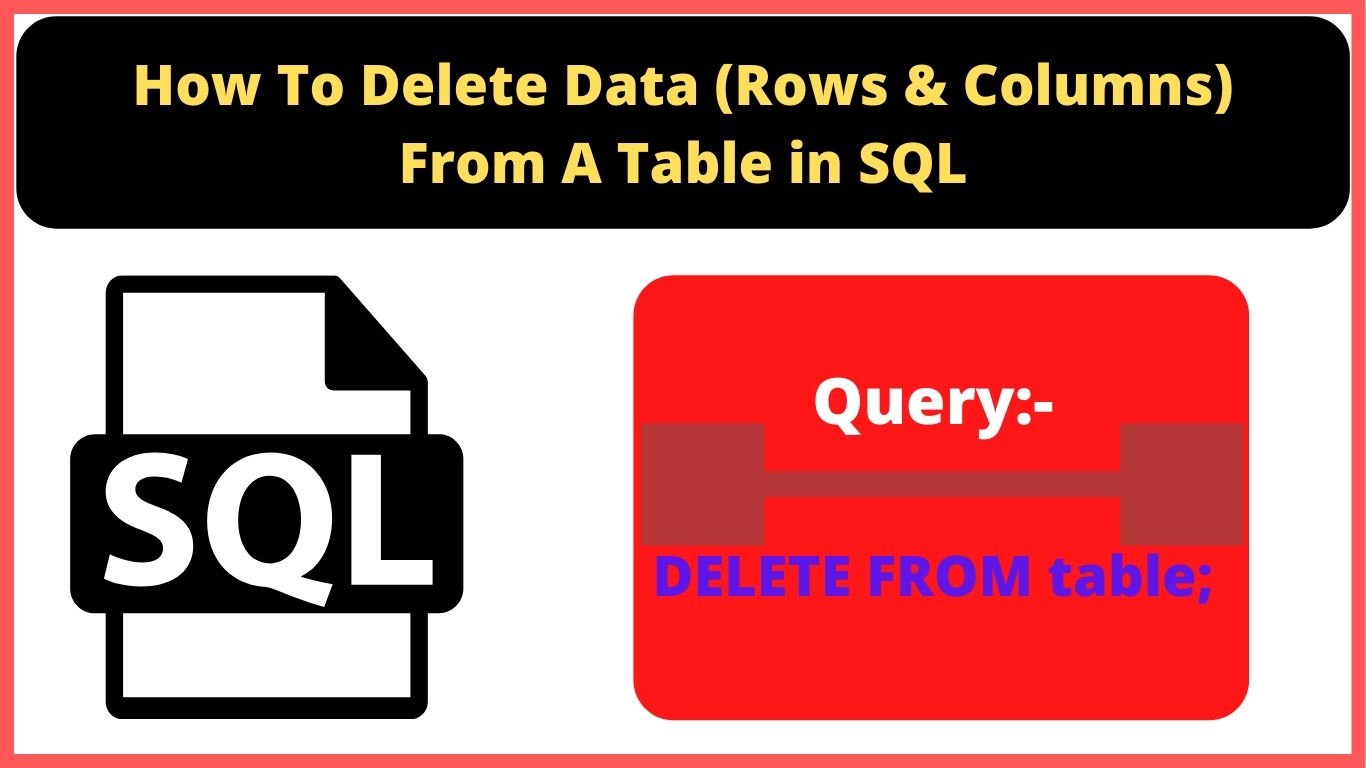Are you trying to Delete Data in SQL?
This guide will help you.
The SQL DELETE Query is used to delete the existing records from a table.
In SQL, the DELETE statement is one of the most powerful operations available to users.
The DELETE operations irreversibly delete one or more rows of data from a database table.
Here at Ibmi Media, as part of our Server Management Services, we regularly help our Customers to manage SQL database servers.
In this context, we shall look into how the DELETE statement works.
How to Delete Data in SQL using the DELETE statement ?
Now we will see how the DELETE statements can be used to delete data in the SQL server.
We will be doing this on a Ubuntu 20.04 server with a non-root user with administrative privileges and a firewall configured with UFW.
Also, we need to ensure that server has some type of relational database management system (RDBMS) that uses SQL.
The steps which our Support Experts follow for deleting data in SQL server is given below.
1. Connecting To MySQL and Setting Up a Sample Database
If the SQL database system runs on a remote server we need to SSH into the server from the local machine:
$ ssh ibmimedia@your_server_ip
$ mysql -u ibmimedia -pThen we will create a database named deleteDB using the following command:
mysql> CREATE DATABASE deleteDB;We will receive the following output on the successful creation of the database:
Output
Query OK, 1 row affected (0.01 sec)For selecting the deleteDB database, we can run the following USE statement:
mysql> USE deleteDB;Output
Database changedHere we will create a table named clubMembers that has these four columns:
mysql> CREATE TABLE clubMembers (
mysql> memberID int AUTO_INCREMENT PRIMARY KEY,
mysql> name varchar(30),
mysql> homeBorough varchar(15),
mysql> email varchar(30)
mysql> );Next, we will create a table with the following columns as clubEquipment:
mysql> CREATE TABLE clubEquipment (
mysql> equipmentID int AUTO_INCREMENT PRIMARY KEY,
mysql> equipmentType varchar(30),
mysql> brand varchar(15),
mysql> ownerID int,
mysql> CONSTRAINT fk_ownerID
mysql> FOREIGN KEY (ownerID) REFERENCES clubMembers(memberID)
mysql> );After that we will run the following INSERT INTO statement to load the clubMembers table with six rows of sample data:
mysql> INSERT INTO clubMembers (name, homeBorough, email)
mysql> VALUES
mysql> ('Rosetta', 'Manhattan', 'hightower@example.com'),
mysql> ('Linda', 'Staten Island', 'lyndell@example.com'),
mysql> ('Labi', 'Brooklyn', 'siffre@example.com'),
mysql> ('Bettye', 'Queens', 'lavette@example.com'),
mysql> ('Phoebe', 'Bronx', 'snow@example.com'),
mysql> ('Mariya', 'Brooklyn', 'takeuchi@example.com');Likewise, we will run another INSERT INTO statement to load the clubEquipment table with twenty rows of sample data:
mysql> INSERT INTO clubEquipment (equipmentType, brand, ownerID)
mysql> VALUES
mysql> ('electric guitar', 'Gilled', 6),
mysql> ('trumpet', 'Yemehe', 5),
mysql> ('drum kit', 'Purl', 3),
mysql> ('mixer', 'Bearinger', 3),
mysql> ('microphone', 'Sure', 1),
mysql> ('bass guitar', 'Fandar', 4),
mysql> ('acoustic guitar', 'Marten', 6),
mysql> ('synthesizer', 'Korgi', 4),
mysql> ('guitar amplifier', 'Vax', 4),
mysql> ('keytar', 'Poland', 3),
mysql> ('acoustic/electric bass', 'Pepiphone', 2),
mysql> ('trombone', 'Cann', 2),
mysql> ('mandolin', 'Rouge', 1),
mysql> ('electric guitar', 'Vax', 6),
mysql> ('accordion', 'Nonher', 5),
mysql> ('electric organ', 'Spammond', 1),
mysql> ('bass guitar', 'Peabey', 1),
mysql> ('guitar amplifier', 'Fandar', 3),
mysql> ('cello', 'Yemehe', 2),
mysql> ('PA system', 'Mockville', 5);
2. Deleting Data in SQL from a Single Table
Generally, the syntax for deleting data in SQL looks like the following:
mysql> DELETE FROM table_name
mysql> WHERE conditions_apply;However, the WHERE clause is optional. If we omit the WHERE clause, the DELETE statement will delete all rows in the table.
To delete all rows in a table without the need of knowing how many rows deleted, we can use the TRUNCATE TABLE statement.
To find what instruments in the table are made by Korgi, we will run the following query.
mysql> SELECT * FROM clubEquipment
mysql> WHERE brand = 'Korgi';This query returns every column from the clubEquipment table, but only returns rows whose brand column contains the value Korgi:
Output
+-------------+---------------+-------+---------+
| equipmentID | equipmentType | brand | ownerID |
+-------------+---------------+-------+---------+
| 8 | synthesizer | Korgi | 4 |
+-------------+---------------+-------+---------+
1 row in set (0.00 sec)To delete this row we can run a DELETE operation that has FROM and WHERE clauses identical to the previous SELECT statement:
mysql> DELETE FROM clubEquipment
mysql> WHERE brand = 'Korgi';Output
Query OK, 1 row affected (0.01 sec)This output indicates that the DELETE operation only affected a single row.
However, we can delete multiple rows of data with any WHERE clause that returns more than one row.
The following SELECT query returns every record in the clubEquipment table whose equipmentType column contains the word electric:
mysql> SELECT * FROM clubEquipment
mysql> WHERE equipmentType LIKE '%electric%';Output
+-------------+------------------------+-----------+---------+
| equipmentID | equipmentType | brand | ownerID |
+-------------+------------------------+-----------+---------+
| 1 | electric guitar | Gilled | 6 |
| 11 | acoustic/electric bass | Pepiphone | 2 |
| 14 | electric guitar | Vax | 6 |
| 16 | electric organ | Spammond | 1 |
+-------------+------------------------+-----------+---------+
4 rows in set (0.00 sec)Again, to delete these four records, we can rewrite this query operation and replace SELECT * with DELETE:
mysql> DELETE FROM clubEquipment
mysql> WHERE equipmentType LIKE '%electric%';Output
Query OK, 4 rows affected (0.00 sec)3. Deleting Data from Multiple Tables
We can delete data from more than one table in a single operation by including a JOIN clause.
JOIN clauses will combine rows from two or more tables into a single query result.
They do this by finding a related column between the tables and sorting the results appropriately in the output.
The syntax for a DELETE operation that includes a JOIN clause as given below:
mysql> DELETE table_1, table_2
mysql> FROM table_1 JOIN table_2
mysql> ON table_2.related_column = table_1.related_column
mysql> WHERE conditions_apply;We will run the following statement to create a table named prohibitedBrands in which we will list the brands that are no longer acceptable for the club.
mysql> CREATE TABLE prohibitedBrands (
mysql> brandName varchar(30),
mysql> homeCountry varchar(30)
mysql> );Then load this new table with some sample data as given below:
mysql> INSERT INTO prohibitedBrands
mysql> VALUES
mysql> ('Fandar', 'USA'),
mysql> ('Givson', 'USA'),
mysql> ('Muug', 'USA'),
mysql> ('Peabey', 'USA'),
mysql> ('Yemehe', 'Japan');Following that, the club decides to delete any records of equipment from the clubEquipment table whose brands appear in the prohibitedBrands table and are based in the United States.
We can use the following statements to implement this.
<mysql> SELECT *
mysql> FROM clubEquipment JOIN prohibitedBrands
mysql> ON clubEquipment.brand = prohibitedBrands.brandName
mysql> WHERE homeCountry = 'USA';
Output
+-------------+---------------+--------+---------+-----------+-------------+
| equipmentID | equipmentType | brand | ownerID | brandName | homeCountry |
+-------------+---------------+--------+---------+-----------+-------------+
| 6 | bass guitar | Fandar | 4 | Fandar | USA |
| 17 | bass guitar | Peabey | 1 | Peabey | USA |
+-------------+---------------+--------+---------+-----------+-------------+
2 rows in set (0.00 sec)To delete these brands from the prohbitedBrands table and the associated equipment from clubEquipment, we canrewrite the previous SELECT statement but replace SELECT * with DELETE followed by the names of both tables:
mysql> DELETE clubEquipment, prohibitedBrands
mysql> FROM clubEquipment JOIN prohibitedBrands
mysql> ON clubEquipment.brand = prohibitedBrands.brandName
mysql> WHERE homeCountry = 'USA';Output
Query OK, 4 rows affected (0.01 sec)[Need urgent assistance with your SQL server? – We can help you. ]
Conclusion
This article covers how to Delete Data in SQL using the DELETE statement.
The SQL DELETE Query is used to delete the existing records from a table.
You can use the WHERE clause with a DELETE query to delete the selected rows, otherwise all the records would be deleted.
In Structured Query Language, more commonly known as SQL, the DELETE statement is one of the most powerful operations available to users.
DELETE operations irreversibly delete one or more rows of data from a database table.
Being such a fundamental aspect of data management, it's important for SQL users to understand how the DELETE statement works.
The basic syntax of the DELETE query with the WHERE clause is as follows:
DELETE FROM table_name
WHERE [condition];You can combine N number of conditions using AND or OR operators.
Note: Be careful when deleting records in a table! Notice the WHERE clause in the DELETE statement.
The WHERE clause specifies which record(s) should be deleted. If you omit the WHERE clause, all records in the table will be deleted!
To Delete All Records:
It is possible to delete all rows in a table without deleting the table. This means that the table structure, attributes, and indexes will be intact:
DELETE FROM table_name;
DROP is used to delete a whole database or just a table. The DROP statement destroys the objects like an existing database, table, index, or view. A DROP statement in SQL removes a component from a relational database management system (RDBMS).
This article covers how to Delete Data in SQL using the DELETE statement.
The SQL DELETE Query is used to delete the existing records from a table.
You can use the WHERE clause with a DELETE query to delete the selected rows, otherwise all the records would be deleted.
In Structured Query Language, more commonly known as SQL, the DELETE statement is one of the most powerful operations available to users.
DELETE operations irreversibly delete one or more rows of data from a database table.
Being such a fundamental aspect of data management, it's important for SQL users to understand how the DELETE statement works.
The basic syntax of the DELETE query with the WHERE clause is as follows:
DELETE FROM table_name
WHERE [condition];You can combine N number of conditions using AND or OR operators.
Note: Be careful when deleting records in a table! Notice the WHERE clause in the DELETE statement.
The WHERE clause specifies which record(s) should be deleted. If you omit the WHERE clause, all records in the table will be deleted!
To Delete All Records:
It is possible to delete all rows in a table without deleting the table. This means that the table structure, attributes, and indexes will be intact:
DELETE FROM table_name;
DROP is used to delete a whole database or just a table. The DROP statement destroys the objects like an existing database, table, index, or view. A DROP statement in SQL removes a component from a relational database management system (RDBMS).












